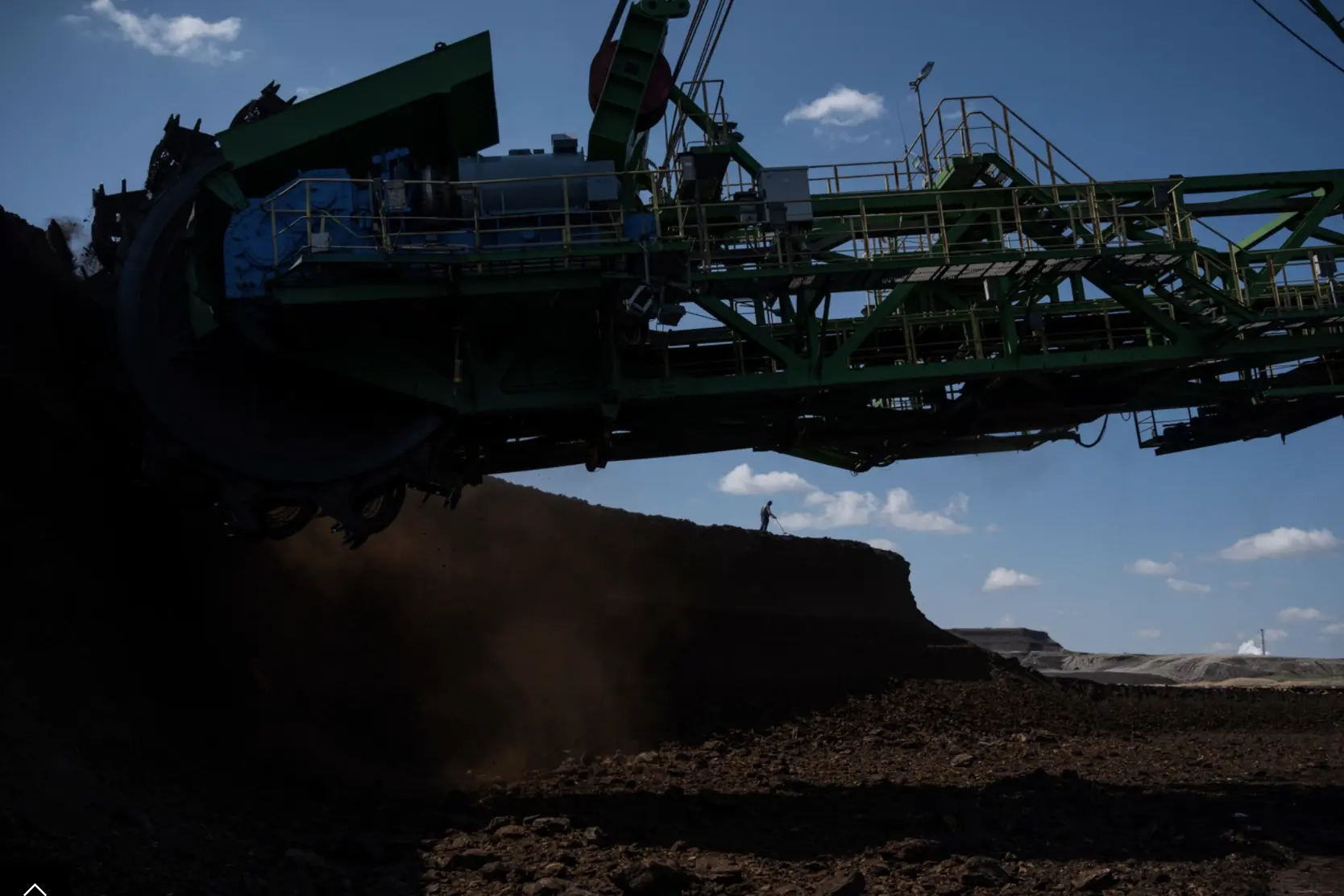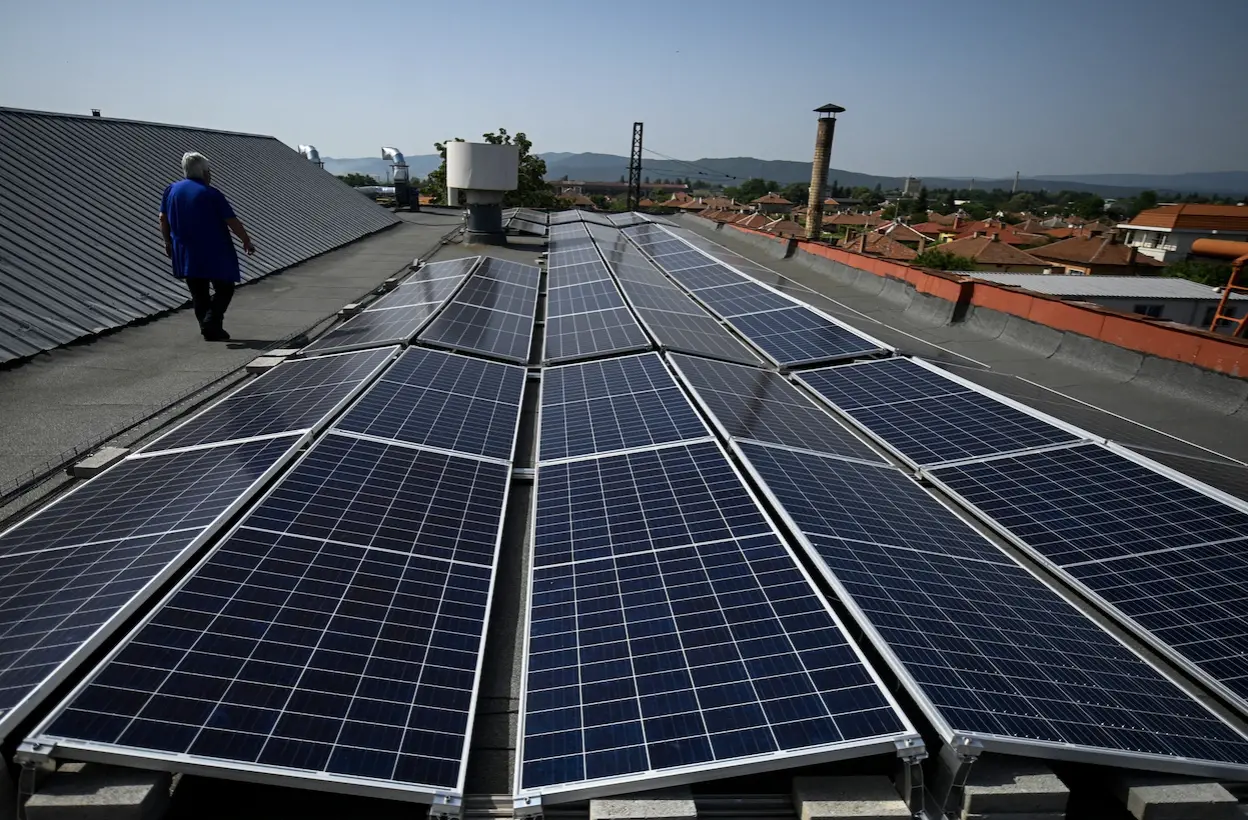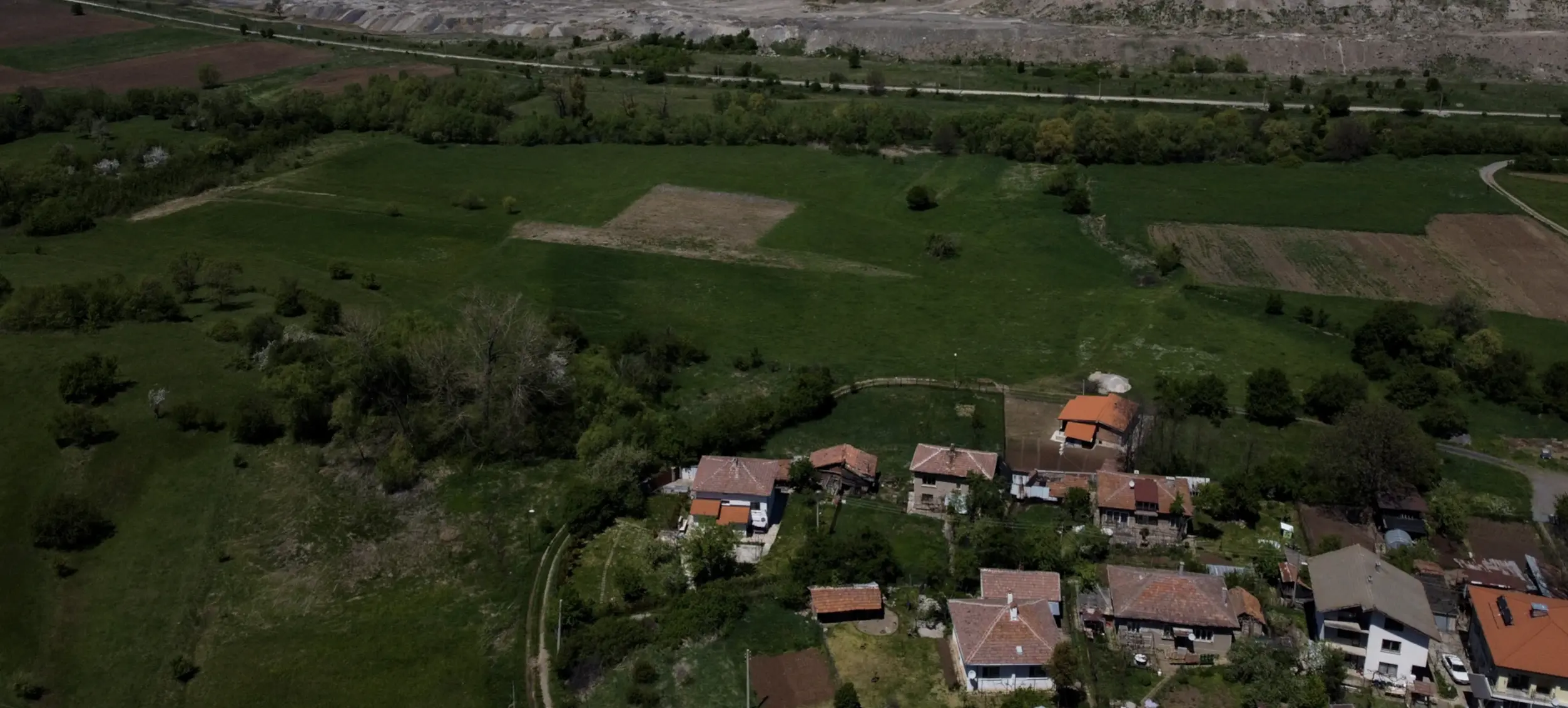When Elina Ivanova drives her two daughters to their primary school in Pernik, a Bulgarian city about 40 minutes from the capital of Sofia, she passes the Republika Power Plant.
The coal-fired power plant was built in 1951 and is the oldest one operating in Europe. Outside, the massive brick complex has gaping broken windows and rusting metal siding. It looks abandoned except for the steam rising from the cooling tower and leaking from other openings in the building. A tree grows on the roof.
In 2018, Ivanova and her family moved back to Pernik, her hometown, after living in Dusseldorf, Germany. Her children were one and three at the time. Almost immediately after returning, their health deteriorated.

As a nonprofit journalism organization, we depend on your support to fund more than 170 reporting projects every year on critical global and local issues. Donate any amount today to become a Pulitzer Center Champion and receive exclusive benefits!
“I was shocked when the kids started coughing more,” Ivanova said.

The year before Ivanova moved back to Bulgaria, the air quality in the town was regularly breaching European pollution limits, and the Republika plant was a prime reason.
Coal is at an inflection point across the European Union. The bloc has stepped up its carbon emissions reduction target for 2030 to 55 percent below 1990 levels. But several Eastern European countries have been slow to embrace the need to phase out coal, the most polluting fuel, according to a European Council on Foreign Relations analysis. Poland, for example, still generates more than 70 percent of its electricity from coal.
Bulgaria, an EU member since 2007, relies on coal for about 40 percent of its electricity. Though its carbon emissions have declined by 44 percent since 1990, much of the drop came when the communist government and its inefficient industry collapsed—and because emigration and a low birth rate have given Bulgaria one of the world’s fastest declining populations. Even so, Bulgaria’s per capita carbon emissions are in the middle of the European pack and higher than France or Italy, although it is the poorest country in the EU.
For the past decade, the Bulgarian government has opted to protect its coal industry instead of transitioning to renewable energy. The state subsidizes coal-fired power plants both directly and by paying for credits on the EU’s carbon market.
But that is starting to change. This October, in order to access the EU financing available under the “European Green Deal” and COVID recovery plan, Bulgaria set a coal phase-out date of 2038. That’s later than some other European countries—but it’s the first time the country has said it would stop mining and burning coal before its reserves run out.
In Pernik, the pressing concern is not so much the warming planet as the filthy air. In 2018, the privately owned Republika plant, which provides both electricity and heat for the city, started replacing some of the coal it burns with biomass—a catch-all term that includes wood and bales of hay. Since the EU considers biomass a sustainable source of energy, this helps the plant avoid the rising cost of carbon emissions. But it still produces harmful fine particles, and air pollutants escape the plant’s filters that were built for coal and haven’t been updated.
Upon returning to Pernik, Ivanova’s daughters had runny noses and sore throats more often. It took longer for them to recover from any illness. Doctors in the city diagnosed them simply with “allergies.” For now, Ivanova has resorted to the same temporary fix her own parents used when she was a kid struggling to breathe in Pernik: going to the nearby mountains where the air is cleaner.
“But I found the solution,” she said. “To turn off Republika Power Plant.” For now, that solution remains aspirational.
Dirty fuel, heavy subsidies

Pernik is the birthplace of Bulgarian coal mining, and its town crest is still topped with two crossed miner’s picks. At the end of the 19th century, the underground mine and enterprises that grew around it propelled Pernik’s development as a city. That mine closed in the ‘60s and is now a museum. Today, privately owned open pit mines supply coal to Republika.
Meanwhile, in the Stara Zagora province, east of Sofia, the open pit Mini Maritsa Iztok mine opened in 1954 as part of the communist government’s national project to industrialize the country. It’s now Bulgaria’s biggest, sending trainloads of coal to four nearby power plants: the state-owned Maritsa Iztok II, the country’s largest coal-fired plant; two plants primarily owned by American companies; and Brikel, which is linked to the same Bulgarian owner as Republika. Collectively, the Maritsa complex generates more than a quarter of the country’s electricity.
Today, the state-owned mines and power plants operate at a financial loss and are subsidized by the Bulgarian government. Last year the subsidies amounted to about $520 million (450 million euros), including EU carbon allowances. (The government even covers the American-owned plants’ emissions.) This year, with the price of carbon in the EU hitting new heights, they’re likely to go even higher.
In both Pernik and Stara Zagora, the mines dig up lignite, which is softer, less energy rich, and more polluting than hard coal. In addition to carbon, burning lignite sends particulate matter (PM), sulphur dioxide (SO2), nitrogen oxides (NOx), heavy metals and other pollutants into the air. Fine particulate matter, especially the tiny PM2.5—so called because it is under 2.5 micrometers in diameter—can cause cardiovascular and lung disease, while sulphur dioxide is known to aggravate asthma. Bulgaria has the worst sulphur dioxide pollution in the EU and has been referred to the EU Court of Justice for violating the bloc’s air-quality standards.
“There's no way you can overstate it,” said pulmonologist and former member of Parliament Alexander Simichiev. “It's something that influences every organ and system in the human body. We breathe 16 times a minute. And every breath we take is a breath that is tainted with some kind of pollution.”
New politics
Simichiev is a member of the Democratic Bulgaria coalition, one of the political forces that shook up the country’s government in elections last April. That ended a decade of politics dominated by former Prime Minister Boyko Borisov and his Citizens for European Development of Bulgaria (GERB) party. Under Borisov, the government said it would burn coal for the next 50 years. Last year, the parliament passed a formal decision stating that the Maritsa Iztok II power plant would continue operating regardless of EU law and policy.
The April elections didn’t produce a stable government, and the country is currently in political limbo, with another round of parliamentary elections and a presidential election scheduled for November 14.
That has left the caretaker government in power since May responsible for completing the country’s National Recovery and Resilience Plan, required by the EU to access billions in grant funding. Although early drafts stated the country would burn coal until its reserves ran out, the final plan sets a 2038 end date and calls for establishing a coal phase-out commission.

“Even if there's a high cost of protecting the planet, we will do so,” said former Deputy Energy Minister Alexander Nikolov, who was part of the government until August. “If we delay, the price we will be paying—and I’m not referring to money—will be considerably higher.”
The EU’s Green Deal, which aims to get the bloc to carbon neutrality by 2050, will ease the financial cost of Bulgaria’s energy transition. The Just Transition Fund focuses on retraining miners and diversifying economies heavily invested in coal and other emissions-heavy industries; Bulgaria is one of the fund’s largest beneficiaries, eligible for $1.4 billion (1.2 billion euros). It’s also entitled to $7.6 billion (6.6 billion euros) in EU COVID recovery funds, which are meant to be used on the actual infrastructure transition, energy efficiency, and other aspects of building renewable energy systems.
Currently, wind and solar energy provide about 8 percent of Bulgaria’s electricity, but another two gigawatts of solar are in the pipeline, Stefanov said. Solar energy has advanced mostly because businesses are installing their own panels to lower energy costs. Effectively the entire country has solar potential, according to the International Renewable Energy Agency, and the recently submitted national plan aims to ease the current complicated regulatory process to install panels. Its wind potential, especially offshore in the Black Sea, is also substantial.
After a decade of reluctance to let go of both coal and centralized state energy production, most electricity in Bulgaria still comes from the Maritsa complex and the country’s sole nuclear power plant. The new national energy plan put forward by the caretaker government looks to a more distributed network in the future, said Kaolyan Stoychev, advisor to Deputy Prime Minister Atanas Pekanov, who was responsible for the plan.
“We hope to implement this huge paradigm shift of energy production,” Stoychev said.
The plan still needs to be approved by the EU. The government that forms after the November 14 elections—assuming one does—will pick up the responsibility for implementing it.
Win-win
Ending coal burning would offer clear health benefits to Bulgarians—though the extent of those benefits would depend on whether some other fuel is burned in place of coal. The national energy plan proposes building both a new gas-fired plant and 1.7 gigawatts of renewables.
Although gas has lower health impacts than coal, they aren’t zero, said Vlatka Matkovic, a senior policy officer with the European nonprofit Health & Environment Alliance. Her organization’s assessment calls for the bloc to phase out both coal and gas by 2030.
In Pernik, the Republika plant continues to burn coal. On dry and windy days this past summer, the town was engulfed in dust from the coal ash pit, which was not properly covered.
In 2018, as a way of reducing its coal use, the plant burned a reported 162,752 tons of waste and biomass. It was this experiment that led to the creation of “Breathe, Pernik,” the citizens’ association that is battling the plant.
“There was a smell everywhere,” said Elina Ivanova, who joined the association in 2018. “All of my friends, their kids in the autumn of 2018, they were sick. They had runny noses, coughs, temperatures.” Republika did not respond to requests for interviews for this story.
More recently, Republika has proposed a permanent switch to burning biomass for up to 70 percent of its fuel needs. The regional environmental inspector has been sitting on the proposal. It hasn’t decided if the plant should be required to perform an environmental impact assessment. In addition to electricity, the plant also supplies heat to many public buildings and residences.

“I have the feeling that the institutions don’t want to point a finger too much against the power plant,” said Meglena Antonova of Greenpeace Bulgaria. “But we feel like the law is very clear about this. If they’re burning such a big amount of biomass, they're still obliged to do the environmental impact assessment.”
Pernik Deputy Mayor Stefan Krastev said he doesn’t support the plan to burn biomass. He’d like to use EU funds to shift the city from centralized power to energy cooperatives, where each neighborhood in the city has its own little power station. He is applying for technical assistance to figure out the best source of energy for the area.
For Ivanova, worried about the air her children breathe, the pace of change feels too slow. She rattles off the list of renewable energy sources that could power her city: solar, wind, geothermal.
“Why don't you just invest now?” Ivanova said, talking about the city government. “When you have the support of the European Union and everything in order to get green energy. They just want to wait.”
“I'm getting angry sometimes because I want to change things,” she said. “I want to change things fast.”












